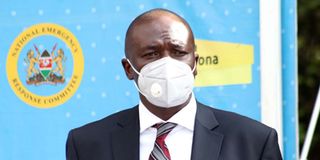Crisis looming as infections, deaths increase

What you need to know:
- Already, Nairobi, the country’s virus hotbed, has run out of admission space, and the government has now resorted home-based care as it seeks ways of transferring patients to other counties.
In the past two weeks, the size of the testing samples has shrunk, due to shortages of testing materials.
Kenya is staring at a Covid-19 crisis as infections inch close to 20,000 and the daily death toll continues in double digits.
Already, Nairobi, the country’s virus hotbed, has run out of admission space, and the government has now resorted home-based care as it seeks ways of transferring patients to other counties.
In addition, testing centres are no longer accepting walk-in clients, while little or no contact tracing is going on in counties. The national testing capacity is still low compared to demand.
The situation recently prompted the World Health Organization (WHO) to raise the alarm, warning of widespread infections, community transmission and deaths if urgent measures are not taken.
In a letter to Health Cabinet Secretary Mutahi Kagwe, the UN health agency asked Kenya to increase its testing capacity and give results on time to allow data-driven interventions, including isolation of confirmed cases.
In the past two weeks, the size of the testing samples has shrunk, due to shortages of testing materials.
This has affected the time for getting results from 24 hours to seven days in some cases, in turn affecting contact tracing and isolation of positive cases.
STRATEGY FAILED
Dr Andrew Were, the President of the Kenya Medical Association (KMA), agreed with the WHO that the government’s contact tracing strategy has failed.
He told the Nation that reliance on community health volunteers and public health officers initially worked because the numbers were low.
“They should have employed technology to help with contact tracing. This would ensure they don’t drop the ball,” he said.
Dr Majid Twahir, Associate Dean for Clinical Affairs at the Aga Khan University Hospital, said the strategy worked at first because there were few chains of transmission.
However, as cases rose and spread to nearly all counties, it became difficult to do effective tracing, especially in the rural areas.
The situation is no better in the counties as the virus spreads in villages.
In the letter, WHO Representative to Kenya Rudi Eggers recommended that densely populated areas be given special attention in Covid-19 interventions, as this will significantly reduce transmission.
But in a new strategy developed by the Health ministry, there will be no mass testing.
A draft document under discussion says only those with symptoms, their contacts and in quarantine centres will be tested.
TESTING
“We have been doing well when it comes to testing, but testing everyone who turns up is very expensive,” said Dr Patrick Amoth, the acting Health director-general.
And despite the introduction of home-based care, which the ministry has praised for speeding up recovery and reducing costs, some patients have been left to their own devices.
The Nation has also established that there is no clear system for tracking down those disregarding the measures set by the ministry.
In its letter, the WHO criticised the government for not protecting healthcare workers.
So far, 683 medics been infected, with eight dead. Their major complaint remains the substandard personal protective equipment they are given.
“Protect the healthcare workers by providing adequate and timely PPEs to all and by training them on requirements of infection prevention and control, including those tracing community cases,” the WHO says.
“Those who fall ill require dedicated medical attention and care in designated facilities for healthcare workers,” it adds.
The agency asked the government to release funds to enable the counties to buy equipment and equip their facilities. It added that this will enable counties to do contact tracing and provide critical things like oxygen and manage resources better.






